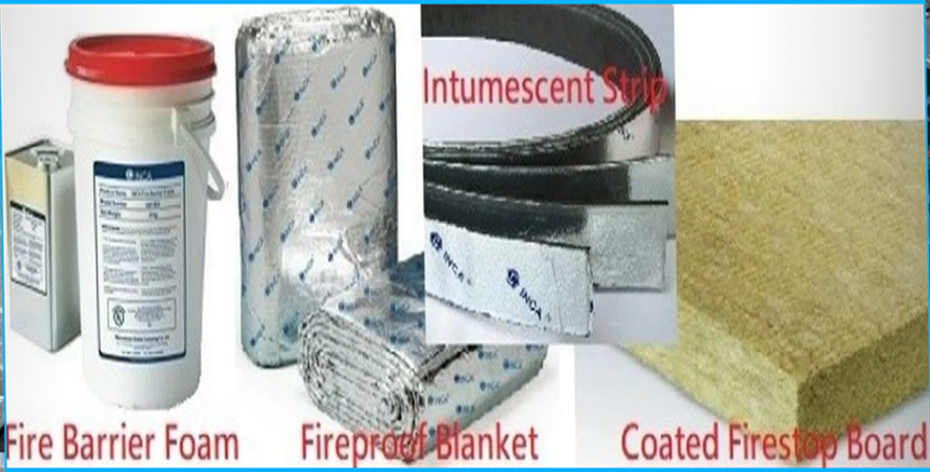Fire stopping materials are critical components of passive fire protection systems, designed to limit the spread of fire and smoke through openings and joints in fire-rated walls, floors, and ceilings.
As construction methods evolve and building designs become more complex, fire stopping technologies and materials continue to advance, offering enhanced safety, compliance, and sustainability. This article
explores the latest innovations, applications, and importance of fire stopping materials in modern construction.
The Importance of Fire Stopping Materials
In any building, gaps and penetrations caused by pipes, ducts, cables, and joints create pathways for fire and smoke to spread rapidly. Fire stopping materials play a crucial role in sealing these gaps,
ensuring that fire-rated barriers maintain their integrity. Key benefits include:
1. Containment of Fire and Smoke: Prevents the spread of fire, smoke, and toxic gases between compartments.
2. Protection of Occupants: Provides additional time for evacuation and facilitates safer conditions for emergency responders.
3. Compliance with Building Codes: Ensures adherence to fire safety standards and regulations, such as the National Building Code (NBC) of India and international standards like ASTM and EN.
4. Preservation of Property: Limits fire damage, reducing repair costs and downtime.
Types of Fire Stopping Materials
The wide variety of fire stopping materials available today cater to different construction needs and fire rating requirements. These include:
1. Intumescent Sealants
- Properties: Expand when exposed to heat, creating an insulating barrier to block fire and smoke.
- Applications: Used around penetrations like pipes, cables, and ducts.
- Advantages: Easy to apply, versatile, and effective for various substrates
2. Fire-Resistant Mortars
- Properties: High-strength cementitious materials that harden to seal larger openings.
- Applications: Ideal for cable trays, conduits, and structural penetrations.
- Advantages: Durable and capable of handling heavy loads.
3. Firestop Collars and Wraps
- Properties: Pre-formed devices that expand to seal combustible pipes during a fire.
- Applications: Used on plastic pipes and conduits.
- Advantages: Easy to install, reliable, and effective for dynamic environments.
4. Fire-Resistant Boards
- Properties: Non-combustible panels that provide fire-rated seals.
- Applications: Used for sealing larger openings and creating barriers.
- Advantages: Durable, reusable, and suitable for high-temperature applications
5. Firestop Pillows
- Properties: Compressible pillows filled with fire-resistant materials.
- Applications: Ideal for temporary or flexible sealing of cable trays and gaps.
- Advantages: Reusable and easy to reposition
6. Silicone Firestop Sealants
- Properties: Flexible, high-performance sealants resistant to fire, water, and air.
- Applications: Suitable for joints, glazing, and other critical areas.
- Advantages: Long-lasting and compatible with various building materials.
Innovations in Fire Stopping Materials
Recent advancements in fire stopping technologies focus on improving performance, sustainability, and ease of application. Key innovations include:
1. Eco-Friendly Materials
- Growing emphasis on sustainability has led to the development of low-VOC (volatile organic compounds) and eco-friendly fire stopping materials. These products reduce environmental impact without compromising performance
2. Smart Fire Stopping Solutions
- Fire stopping materials integrated with sensors and monitoring systems provide real-time data on the integrity of fire seals. These smart systems alert building managers to potential vulnerabilities.
3. Hybrid Materials
- Advanced hybrid materials combine the benefits of multiple fire stopping products, offering enhanced durability, flexibility, and fire resistance.
4. Pre-Fabricated Systems
-
Modular and pre-fabricated fire stopping solutions streamline installation, reduce labor costs, and ensure consistent quality.
Applications of Fire Stopping Materials
Fire stopping materials are used across various sectors and building types to ensure comprehensive fire safety. Key applications include:
1. Residential Buildings
-
Ensuring fire safety in multi-family housing units by sealing penetrations in fire-rated walls and floors.
2. Commercial Spaces
-
Protecting office buildings, malls, and retail spaces with robust fire stopping solutions for HVAC systems, cable trays, and partitions.
3. Industrial Facilities
-
Fire stopping materials are essential in factories and warehouses, especially for high-risk areas with large penetrations and hazardous materials.
4. Healthcare and Educational Institutions
-
Ensuring safe environments in hospitals, schools, and universities by containing fire and smoke spread.
5. High-Rise Buildings
-
Sealing vertical and horizontal openings in skyscrapers to prevent the rapid spread of fire between floors.
Challenges in Fire Stopping
While fire stopping materials are indispensable, they come with their own set of challenges:
1. Proper Installation: Fire stopping requires skilled professionals to ensure materials are applied correctly and meet fire safety standards.
2. Maintenance and Inspection: Over time, penetrations may be modified or new gaps created, requiring regular inspections and reapplication.
3. Compatibility Issues: Ensuring compatibility between fire stopping materials and other building components can be complex.
4. Cost Considerations: High-performance materials may increase upfront costs, though they save costs in the long term through improved safety and reduced damage.
Regulations and Standards
Compliance with fire safety codes and standards is non-negotiable. In India, the NBC specifies fire stopping requirements, while globally recognized standards like ASTM E814 and EN 1366 guide material testing and performance evaluation. Adherence to these standards ensures that fire stopping systems perform effectively during emergencies.
Future Trends in Fire Stopping
The field of fire stopping is evolving, driven by technological advancements and changing building requirements. Future trends include:
1. AI-Driven Monitoring: Integration of artificial intelligence to monitor and predict the performance of fire stopping systems.
2. Automation in Installation: Robotic systems for precise and efficient application of fire stopping materials.
3. Integration with BIM: Incorporating fire stopping designs into Building Information Modeling (BIM) to ensure seamless planning and execution
4. Sustainable Practices: Continued focus on eco-friendly materials and recycling solutions.
Conclusion
Fire stopping materials are essential for modern building safety, acting as silent protectors that prevent fire and smoke from spreading through gaps and penetrations. With advancements in materials, technologies, and sustainability, fire stopping systems are becoming more effective and reliable. As regulations tighten and awareness grows, the role of these materials in passive fire protection will continue to expand, safeguarding lives, property, and the environment
